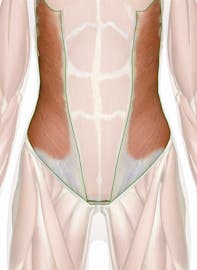The External Abdominal Obliques
Learn about the anatomy and function of the external abdominal obliques with Innerbody's 3D model.

The external abdominal obliques are a pair of broad, thin, superficial muscles that lie on the lateral sides of the abdominal region of the body. Contraction of these muscles may result in several different actions, but they are best known for their lateral flexion and rotation of the trunk known as a side bend. The external obliques get their name from their position in the abdomen external to the internal abdominal obliques and from the direction of their fibers, which run obliquely (diagonally) across the sides of the abdomen.
The external abdominal obliques have their origins along the lateral ribs 5 through 12 and insert into the linea alba of the abdomen, the pubis, and the iliac crest of the hip bones. Their shape is roughly rectangular with the long axis running anterior to posterior along the linea alba. Muscle fibers in the external obliques run medially and inferiorly from the origins to the insertions across the lateral sides of the abdomen and end just lateral to the rectus abdominis muscles.
The location and structure of the external abdominal obliques gives them many different possible actions. Contraction of both external obliques together results in the compression of the abdomen (as in sucking in the gut) or the flexion of the trunk (as in performing a crunch or sit-up). Contraction of one of the abdominal obliques results in the lateral flexion and rotation of the trunk on the opposite side; in other words, the left external oblique rotates and flexes the trunk to the right.


